If your Sceptre monitor isn’t turning on, or you’re seeing the dreaded “no signal” message, don’t worry. This is a common issue, and fortunately, most of the time, it can be resolved in just a few steps. Here’s a detailed guide to get your monitor working again in no time.
1. Check the Power Source
Let’s start with the basics:
- Ensure proper power connection: Make sure the monitor is plugged into a working power outlet. Try different outlets or power strips to rule out a faulty socket.
- Power cable check: Ensure the power cable is firmly connected to both the monitor and the outlet.
If the power indicator on the monitor isn’t lighting up, you may have a power issue.
2. Verify the Monitor’s Input Source
It’s possible the monitor is set to the wrong input source, which can cause the “no signal” error.
- Change input source: Press the input or source button on your monitor to cycle through the options (HDMI, DisplayPort, etc.) to match the one connected to your device.
3. Loose Cable Connections
A loose or faulty cable can easily result in a no-signal message.
- Check HDMI/DisplayPort cables: Ensure they’re securely connected at both ends. If you have a spare, try swapping the cables.
- Damaged ports: Inspect the ports on both the monitor and your computer for any signs of damage. If the pins inside an HDMI or DisplayPort are bent or broken, you may need to replace or repair the port.
4. Test With a Different Device
It could be that your monitor isn’t receiving a signal from your computer. Try connecting the monitor to a different device, such as a laptop or gaming console, to determine if the monitor itself is working.
5. Check for Sleep Mode
Monitors sometimes go into sleep or power-saving mode if they aren’t receiving a signal.
- Wake it up: Press a key on the keyboard or move the mouse to see if the monitor comes back to life.
- Disable power-saving mode: On your PC, go to Settings > System > Power & Sleep Settings and set the monitor to never sleep to prevent future issues.
6. Reset Display Settings
Incorrect display settings can prevent the monitor from displaying a signal.
- Reset display settings: On your PC, try pressing Windows key + P and select “PC screen only” to ensure the monitor is using the correct display mode.
7. Inspect the Graphics Card
If your graphics card isn’t functioning properly, it can prevent your monitor from displaying anything.
- Check connections: Ensure the GPU is securely seated in the PCIe slot and that the connection between the monitor and GPU is tight.
- Clean the GPU: Dust and debris can accumulate over time and interfere with performance. Use compressed air to blow away any dust from the GPU.
8. Check for a Faulty GPU or RAM
Sometimes the issue may lie in faulty internal components like the GPU or RAM:
- Test GPU: If your monitor still shows no signal, you may have a faulty GPU. You can clean it using compressed air and check if it’s working properly. If the GPU appears to be the issue, consider testing with a different one if possible.
- Faulty RAM: If the RAM is malfunctioning, your computer may fail to send the correct display signal. Try reseating or replacing the RAM modules.
9. Corrupted BIOS Settings
Corrupted BIOS settings can occasionally interfere with your monitor’s ability to receive a signal.
- Reset the BIOS: You can reset the BIOS by pressing or holding the CMOS reset button on the motherboard or by using a jumper switch. This can restore the settings to default and resolve any corruption.
10. Faulty Cables
Poor-quality or damaged cables can prevent a monitor from receiving a signal.
- Replace faulty cables: If your cables show signs of fraying or damage, replacing them with new, high-quality HDMI or DisplayPort cables may solve the problem.
11. Wrong Input Source
Ensure that the monitor and connected device are compatible and using the right input source.
- Check compatibility: Make sure you’re using a compatible cable (HDMI for HDMI port, DisplayPort for DisplayPort) and that the correct input is selected on the monitor. Mismatched inputs can result in a “no signal” error.
12. Contact Sceptre Support
If none of these steps work, it’s possible the issue is hardware-related. Contact Sceptre’s customer support to explore repair or replacement options.
Final Thoughts
Most of the time, a monitor not turning on or showing a “no signal” error can be traced back to simple fixes like cable issues, wrong input sources, or incorrect settings. By following these steps, you can likely resolve the issue quickly without much hassle. If you’ve tried everything and the monitor still won’t display, it might be time to contact Sceptre for further assistance.
